2010 STD Surveillance Graphics
Click on a graphic to view it in high resolution.
Images and graphics highlighting major findings of the report are available for download. These high-resolution, public domain images are ready to print in your publication.
These images are in the public domain and are thus free of any copyright restrictions. As a matter of courtesy, we request that the content provider be credited and notified of any public or private usage of an image.
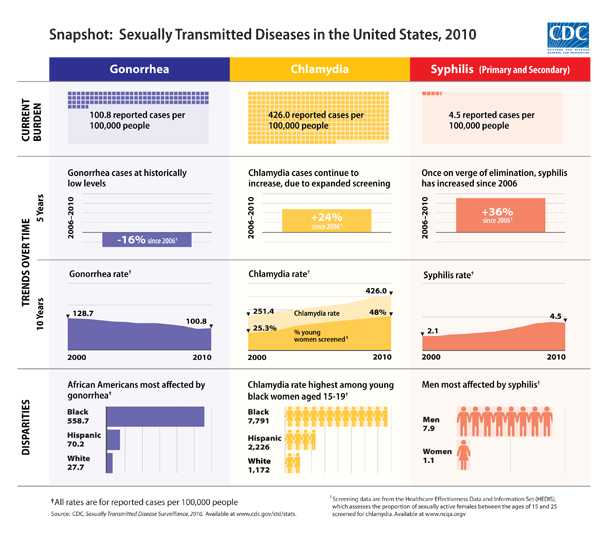
This graphic contains twelve individual charts illustrating the overall burden, trends over time and racial and ethnic disparities in reported cases of gonorrhea, chlamydia and syphilis in the U.S. in 2010. View High Resolution Version
Gonorrhea Graphics – High Resolution Available Below
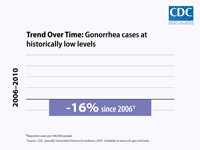
This bar chart shows that reported cases of gonorrhea are at historically low levels, with a 16 percent decline between 2006 and 2010. View High Resolution Version
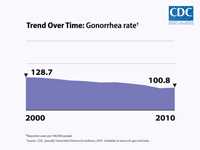
This chart shows in 2000, there were 128.7 reported cases of gonorrhea per 100,000 people, decreasing to 100.8 reported cases per 100,000 people in 2010. View High Resolution Version
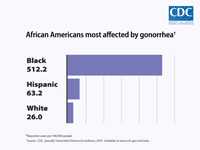
This bar chart shows reported rates of new gonorrhea infections in 2010 by race and ethnicity, with African Americans being the most affected. Blacks accounted for 512.2 reported cases per 100,000 people; Hispanics accounted for 63.2 reported cases per 100,000 people and whites accounted for 26.0 reported cases per 100,000 people. View High Resolution Version
Chlamydia Graphics – High Resolution Available Below
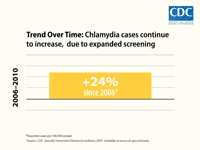
This bar chart shows that expanded Chlamydia screening resulted in a 24 percent increase in reported Chlamydia cases between 2006 and 2010. View High Resolution Version
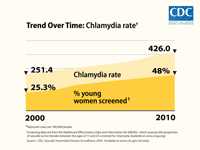
The rate of reported Chlamydia cases in the U.S. increased between 2000 and 2010, mirroring an increase in the percentage of young sexually active women who have been screened for the disease over the same time period. In 2000 the Chlamydia rate was 251.4 per 100,000 people and increased to 426.0 per 100,000 people in 2010. In 2000, 25.3 percent of young women were screened for Chlamydia; increasing to 48 percent in 2010. View High Resolution Version
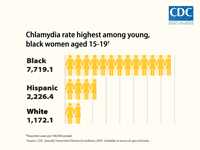
Young women bear a disproportionate burden of Chlamydia with the highest rate – 7,719.1 reported cases per 100,000 people – among black women aged 15-19; compared to 2,226.4 reported cases per 100,000 people among Hispanic women aged 15-19 and 1,172.1 reported cases per 100,000 people among white women aged 15-19. View High Resolution Version
Syphilis Graphics – High Resolution Available Below

This bar chart shows that reported cases for syphilis, once on the verge of elimination, has increased 36 percent from 2006 to 2010. View High Resolution Version

This chart shows in 2000, there were 2.1 reported cases of syphilis per 100,000 people, increasing to 4.5 reported cases of syphilis per 100,000 people in 2010. View High Resolution Version
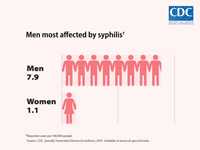
Men are most affected by syphilis with a rate of 7.9 cases per 100,000 compared to 1.1 cases per 100,000 reported among women, in 2010. View High Resolution Version
- Page last reviewed: November 17, 2011
- Page last updated: December 20, 2013
- Content source:


 ShareCompartir
ShareCompartir

